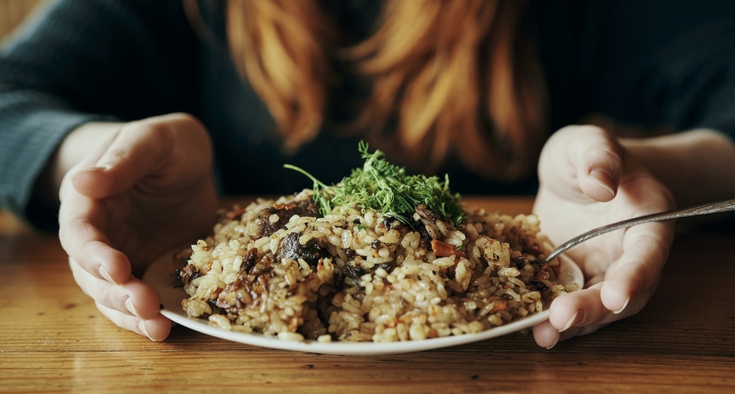Trying to lose weight to improve your health or for a special occasion? Chances are, if you’re like nearly 50% of people in the U.S., you’ve already decided to go on a diet, hoping to shed those pounds quickly. There’s just one problem: Diets seldom work.
In fact, research shows that only 20% of overweight people are able to lose weight and keep it off for at least a year. The remaining 80%, however, are unable to maintain that loss and face increased risk for obesity-related conditions like cardiovascular disease and cancer. So, how can we set ourselves up for success?
Relying on healthful nutrition and regular exercise to lose weight has been shown to be more achievable and more sustainable. It allows you to get used to your new healthy habits — and your body time to adjust — versus a crash or fad diet that’s focused only on fast weight loss.
By avoiding the pitfalls of weight-loss programs that overpromise and underdeliver, we can avoid the hunger, frustration and effects of poor nutrition that derail the most dieters.
Here’s what to avoid — and embrace — to ensure you lose weight and stay healthy. (Including two recipes, below, inspired by the ultra-nutritious and effective Mediterranean diet.)
We’re here to help with weight
Struggling to lose weight? Want help with healthier eating? Or maybe you need a hand with Type 2 diabetes? Novant Health doctors and other specialized clinicians are ready to help.
- CoreLife: CoreLife Novant Health offers you a way to get to a healthy weight and address medical conditions that keep you from living the life you want.
- Bariatrics and weight-loss surgery: Click here to reach team members who will contact you to discuss your needs or schedule an appointment.
- Registered dietitians help us make smart choices. Find one today.
- Diabetes: Whether you are trying to prevent diabetes, learning how to live with it, Novant Health is here to help.
- Primary care providers: Not sure where to start? Book an appointment with your doctor to begin the journey.
1. Avoid plans that promise miraculous health and weight-loss results.
Promises of extreme changes should always raise a red flag. Be cautious of diets that guarantee super-fast, unbelievable results, like losing 20 pounds in a week, curing you of diabetes or helping you get off all of your medications.
You’ll lose weight on extreme diets, but it likely won’t stay off. And, in the process, your body may be deprived of the key nutrients it needs to function well. Your body breaks down muscle tissue when you cut calories drastically, which can result in a slower metabolism and higher body fat percentage when weight is regained.
2. Avoid diets that are unsustainable for you.
“Sustainable” means different things to different people, depending on personality, lifestyle and how much time or money someone can commit.
Many plans, for example, require dieters to commit to tallying up the calories, macronutrients (protein, carbohydrates and fats) or a plan-specific variation (like “points”) for every bite they eat.
Modern technology has taken some of the sting out of the process — which used to involve reference books, pen and paper. But spending time setting up an app and logging daily food intake may be too challenging for anyone with a busy lifestyle.
Depending on their preferences and needs, dieters may also find the following are unsustainable:
- Programs that require shopping for and cooking complicated meals.
- Diets consisting of foods they dislike. Do you really want to eat cabbage soup for the rest of your life?
- Plans with rigid, strict food requirements which can become boring and — when celebrating or dining out — frustrating.
3. Avoid programs that require you to buy expensive, prepackaged foods.
Prepackaged diet foods, bars and shakes can be pricy. Also, the quality can vary tremendously, so it’s important to look at the nutrition facts and ingredients.
Some brands of prepackaged meals offer a balance of protein, produce and whole grains, without excessive sugar, sodium and fat. These could be used as a temporary tool to help teach portion control or how to prepare complete meals.
The real question, though, is whether you’re able or willing to pay what they’re charging for these products in the long run. Realistically, most of us probably wouldn’t continue eating only the prepackaged foods a company delivers.
Instead, try talking with a dietitian to learn economical meal planning strategies, so you can make and freeze “grab-and-go” meals ahead of time. A bonus: You’ll also avoid the additives and preservatives often found in diet meals, bars and shakes.
Signs your weight-loss program could be less-than-healthy.
Trying to lose weight, but feeling a little “off"? If your current diet involves cutting out foods and drastically reducing calories, it may not be providing the nutrients your body needs.
Watch for these signs of a less-than-stellar diet, and work with a registered dietitian to design a weight-loss program that works for you and your body:
- Your skin, hair and nails seem unusually dry or brittle. This signals that you are probably not getting all the nutrients and hydration necessary for glowing skin, shiny hair and strong nails.
- You’re obsessing about all the “bad” foods you’ve told yourself are totally off-limits.
- You’re on a program that requires you to eliminate many foods — or even entire food groups.
- You simply don't feel well — you may have headaches, and be easily fatigued, distracted or irritable.
- You are hungry. All. The. Time. If you’re always cutting back to reduce calories, you may not be getting the fiber and other nutrients you need to feel satisfied.
4. Avoid diets that include “good” foods you’re allowed to eat, and “bad” foods labeled “off-limits.”
Another red flag: Any diet that encourages black-or-white thinking, labeling foods as “good” or “bad.”
Calling all sugar ‘bad,’ and telling yourself you can never have it again is a very inflexible way to approach food. And the moment we tell ourselves something is off-limits, it’s likely to become even more enticing. We start noticing it everywhere we go, which can trigger cravings.
When you try to adhere to a strict diet, giving in to cravings can lead to feelings of remorse and shame, which sets you up for failure in the long run. Plus, eliminating foods can mean limiting nutrition — and taking some of the joy out of eating.
Going with a flexible eating plan like the Mediterranean diet (an eating pattern common to countries that border the Mediterranean) means you’ll be reaching for healthy foods like fruits, vegetables, whole grains and beans, full of filling fiber and important nutrients.
And that helps, in the long run, from a sustainability standpoint — because if you're hungry all the time, you're going to give in. But when you feel satisfied instead of starving, you’re better able to make healthful food choices throughout the day.
5. Avoid a program that is all diet and no exercise.
Often, when you do lose a high amount in a short amount of time, you’re also losing muscle mass, which we definitely want to preserve.
That’s because building and maintaining lean body mass — muscle tissue — actually helps boost the body’s metabolism and helps it burn off more fat. Incorporating strength or resistance training with stretching and aerobic exercise also helps create muscle tone, boost stamina and improve balance.
Doing this, while continuing to nourish your body with enough calories and protein to sustain your muscle tissue, has been very effective in helping people shed pounds and maintain their weight in a healthy way.
Triple citrus salmon
- 1⁄2 cup freshly squeezed orange juice
- 2 tablespoons freshly squeezed lime juice
- 2 tablespoons freshly squeezed lemon juice
- 1 tablespoon extra-virgin olive oil
- Zest of 1 orange
- Zest of 1 lemon
- 1⁄2 teaspoon fresh ginger, minced
- 1⁄4 teaspoon cayenne pepper
- 2 tablespoons water
- 4 (3.5-ounce) salmon fillets, bones removed
- 1⁄4 teaspoon sea salt
- 1 teaspoon Dijon mustard
- 3⁄4 cup coarsely chopped fresh flat-leaf parsley
Directions
In a small bowl, whisk together the citrus juices, olive oil, orange zest, lemon zest, ginger and cayenne.
Place the salmon in a baking dish and season each piece with 1⁄8 teaspoon of the salt. Pour half of the orange juice mixture over the salmon and turn to coat well. Cover and marinate in the refrigerator for 30 minutes.
Heat the oven to 400° F.
Remove the salmon from the refrigerator, uncover and add 2 tablespoons water to the bottom of the dish. Bake just until the fillets are tender and an instant-read thermometer inserted into the center of each filet registers 137° F; this will take 10 to 15 minutes, depending on the thickness of the fillets.
While the fillets are cooking, place the remaining marinade in a small saucepan. Stir in the mustard and remaining salt.
Simmer marinade over medium heat until the liquid is reduced by half. Pour the reduction over the cooked fillets, sprinkle with the parsley and serve.
Nutrition facts (makes 4 servings): 234.3 calories, 11.7 grams fat (1.8 grams saturated fat), 70.4 milligrams cholesterol, 239.9 milligrams sodium, 5.4 grams carbohydrates (3.1 grams sugars, 0.6 grams dietary fiber), 25.9 grams protein.
Adapted from: Healthy Holidays: Recipes for the 2020 Season, Novant Health Heart & Vascular Institute and Novant Health Cancer Institute
Kale with sweet potatoes and pecans
- 2 tablespoons extra-virgin olive oil
- 1 teaspoon fresh ginger, minced
- 1 sweet potato, peeled and diced
- 1⁄8 teaspoon ground cinnamon
- 1⁄4 cup water
- 1 bunch kale, stems removed and chopped
- 1⁄4 teaspoon sea salt
- 2 tablespoons golden raisins
- 1 teaspoon Grade A dark maple syrup
- 2 tablespoons pecans, finely ground
Directions
Heat the oil in a large sauté pan over medium heat, then add the ginger and sauté for 30 seconds, just until aromatic. Add the sweet potato, cinnamon, and water and sauté for about one minute.
Add the kale, salt, and raisins and sauté until the kale is a darker shade of green and the sweet
potatoes are tender, about five minutes. Stir in the maple syrup, then taste; you might need another
pinch of salt.
Serve garnished with the ground pecans. The ground pecans have the same texture as a sprinkling of
finely grated cheese.
Nutrition facts (makes 4 servings): 143.2 calories, 9.2 grams fat (1.2 grams saturated fat), 0 milligrams cholesterol, 178.5 milligrams sodium, 15.1 grams carbohydrates (7.6 grams total sugars, 3 grams added sugars, 2.4 grams dietary fiber), 1.6 grams protein.
Adapted from: Healthy Holidays: Recipes for the 2020 Season, Novant Health Heart & Vascular Institute and Novant Health Cancer Institute











